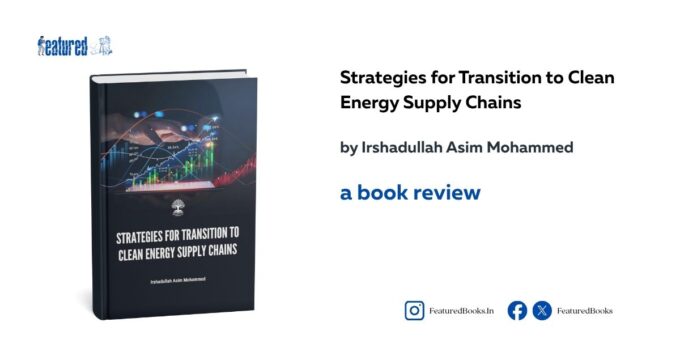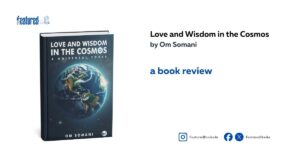Irshadullah Asim Mohammed’s Strategies for Transition to Clean Energy Supply Chains (2023) arrives at a decisive moment in global discourse on sustainability, climate change mitigation, and energy system transformation. It presents a compelling and academically rigorous synthesis of the technological, policy, and systemic challenges associated with building a sustainable, resilient, and digitally empowered clean energy supply chain. The book distinguishes itself through its holistic integration of theory and practice, combining global policy frameworks, industrial innovation, and technological advancements to articulate a comprehensive model for clean energy transition. From an academic perspective, this work is not merely a technical manual or policy compendium; it is an interdisciplinary exploration that draws on economics, systems engineering, environmental science, and global governance.
A Systemic and Structured Approach
The strength of the book lies in its meticulous organisation across sixteen interrelated chapters, which together trace the trajectory from foundational principles to applied strategies and policy recommendations. Beginning with “Understanding Clean Energy Transition,” the author contextualises the climate crisis as a structural and socio-economic issue that transcends technological innovation. The chapter underscores how clean energy is not just an environmental imperative but a vehicle for social equity, energy security, and economic resilience. This framing allows the book to stand apart from more technocratic energy transition texts by situating energy systems within a humanistic and developmental context.
The progression through subsequent chapters, from fundamentals of energy supply chains to policy frameworks, economic dynamics, and technological innovations, reflects a deliberate academic sequencing. The reader is guided from conceptual understanding to practical application. Chapters such as “Digitalization and Automation” and “Supply Chain Optimization” are particularly noteworthy for their detailed engagement with emerging technologies such as Artificial Intelligence (AI), Machine Learning (ML), Internet of Things (IoT), and Blockchain. Rather than treating these as peripheral tools, the author situates them as integral enablers of transparency, efficiency, and resilience in modern supply chains. This integration demonstrates the book’s forward-looking perspective and its capacity to anticipate the evolving technological landscape.
Thematic Depth and Scholarly Relevance
From an academic standpoint, Mohammed’s text exemplifies the characteristics of a multi-disciplinary scholarly work. It unites perspectives from environmental economics, policy analysis, technological innovation, and industrial management, thereby appealing to a wide scholarly audience across energy studies, environmental policy, and sustainable development disciplines. The extensive discussion of policy mechanisms, particularly in “Policy and Regulatory Frameworks” and “Economic and Market Dynamics,” demonstrates the author’s grasp of global governance structures and the economic instruments that underpin the transition.
The inclusion of mechanisms such as carbon pricing, cap-and-trade systems, and feed-in tariffs situates the work within contemporary policy discourse, while references to the Paris Agreement and UN Sustainable Development Goals (SDGs) anchor it within global sustainability paradigms. The analytical tone of these discussions resembles academic treatises on energy policy and public administration, making the book valuable for researchers examining how macroeconomic tools and legal frameworks drive systemic energy reform.
Furthermore, the book’s treatment of resilience, particularly in “Building Resilient Clean Energy Systems,” exemplifies an advanced systems-theory approach. Mohammed argues that resilience is not simply about infrastructural robustness but about adaptive capacity, diversification, and decentralisation. By drawing parallels between past energy crises and contemporary vulnerabilities, he advocates a learning-oriented framework for building systems capable of withstanding geopolitical and environmental shocks. This is both conceptually and pragmatically significant for policy researchers and energy planners.
Bridging Theory and Practice
A distinctive quality of Strategies for Transition to Clean Energy Supply Chains is its emphasis on operationalising theory through actionable insights. This aligns with the author’s stated objective to bridge academic discourse and real-world application. The text does not remain confined to theoretical abstractions; instead, it provides pragmatic frameworks for stakeholders, detailing how policymakers, corporate leaders, and communities can collectively drive the clean energy transition.
The chapters “Supply Chain Optimization,” “Sustainable Practices in Energy Supply Chains,” and “Measuring and Reducing Environmental Impact” exemplify this orientation. For instance, the discussion on localisation strategies—encouraging regional manufacturing, local workforce development, and circular supply chain models—reflects a deep understanding of both economic feasibility and ecological responsibility. The book underscores how circular economy principles, recycling, remanufacturing, and resource efficiency are crucial for the sustainability of renewable energy technologies such as solar panels and batteries. These sections provide measurable and replicable models that can be incorporated into research projects, policy drafts, and corporate sustainability frameworks.
Comparative and Global Dimension
I. Asim Mohammed’s inclusion of extensive global case studies is one of the book’s most pedagogically useful features. The analysis of transitions in Denmark, Germany, China, India, and Kenya offers comparative insights into how diverse political, economic, and technological contexts shape energy strategies. Each case is examined not merely descriptively but analytically, identifying success factors such as policy coherence, public-private partnerships, and technological innovation. For scholars and students of comparative policy or global studies, these case studies function as empirical evidence of theoretical principles discussed earlier in the book.
Moreover, the comparative approach highlights the diversity of pathways toward clean energy adoption. The author’s discussion of India’s decentralised systems and China’s large-scale industrial transition reveals that there is no universal blueprint. Instead, the transition is contingent upon national priorities, resource endowments, and institutional capacities. This reinforces the notion that global energy transformation must be flexible and context-specific, an insight that adds to the book’s academic richness.
Integration of Technology and Governance
What sets this book apart from similar titles in the energy transition genre is its nuanced exploration of digital transformation as a governance tool. The discussion of AI, ML, IoT, and Blockchain technologies in the management of clean energy supply chains elevates the book’s contemporary relevance. While other works, such as Vaclav Smil’s Energy and Civilization or Michael Grubb’s Planetary Economics, emphasise macro-level analyses of energy transitions, Mohammed’s contribution is more technical and operational, addressing the how rather than just the why of clean energy transformation.
By interlinking digitalisation with policy frameworks, the author suggests that governance in the clean energy era will increasingly depend on data-driven decision-making, predictive analytics, and real-time monitoring. This conceptual shift is of immense importance for academics studying the intersection of technology, policy, and sustainability. For practitioners, it demonstrates how digitalisation can de-risk supply chains and promote transparency in carbon reporting and resource management.
Pedagogical Utility and Target Audience
The book’s language and structure demonstrate a conscious intent to cater to a multi-tiered readership—academics, policymakers, industry leaders, and students. For postgraduate and doctoral researchers, the text offers a strong theoretical foundation, replete with frameworks that can inform dissertation topics and comparative analyses. The clear delineation of chapters makes it adaptable for use in university curricula on sustainable energy systems, environmental management, or supply chain studies.
For industry professionals, the book provides operational models that translate academic research into corporate strategy: localisation of supply chains, lifecycle analysis, and digital optimisation are all directly applicable to real-world scenarios. Policymakers, meanwhile, may find the chapters on regulation, market dynamics, and infrastructure particularly valuable in designing policy instruments that balance environmental goals with economic feasibility.
In this sense, the book serves as both a reference manual and a didactic text. Its interdisciplinary framework makes it suitable for use in both business schools and environmental science programmes. Furthermore, its pragmatic orientation aligns well with the increasing global demand for skill-based, sustainability-focused learning in higher education.
Critical Evaluation
While the book’s comprehensive structure is commendable, its dense thematic scope could be overwhelming for general readers unfamiliar with technical terminologies in energy systems or supply chain management. Some sections, particularly those discussing AI and Blockchain, might have benefited from greater contextual simplification or case-based visualisation to improve accessibility. Additionally, while the inclusion of international case studies strengthens the global appeal, more attention to regional disparities, especially in the Global South, would have provided a deeper understanding of structural inequities in the global energy transition.
Nevertheless, these limitations do not detract significantly from the book’s scholarly and practical value. Its interdisciplinary integration, analytical rigour, and solution-oriented outlook make it a substantial contribution to contemporary sustainability literature.
Contribution to Academic and Professional Discourse
Academically, Strategies for Transition to Clean Energy Supply Chains occupies an important niche between theoretical sustainability studies and applied industrial research. It complements existing scholarship on sustainable transitions by adding the missing logistical dimension, the supply chain, as the operational backbone of global decarbonisation. Its emphasis on systemic transformation, digital innovation, and policy integration reflects the multifaceted nature of the challenge and provides a foundation for future interdisciplinary studies in clean energy governance.
For practitioners, the book translates the language of sustainability into tangible strategies, bridging academia and industry in a meaningful way. It redefines the clean energy narrative from being technology-centric to being system-centric, highlighting that sustainability must permeate every link in the energy chain—from material sourcing to end-of-life recycling.
Conclusion
Irshadullah Asim Mohammed’s Strategies for Transition to Clean Energy Supply Chains stands as an authoritative and timely contribution to the global discourse on clean energy transformation. By addressing the nexus of policy, technology, economy, and environment, the author presents a cohesive roadmap for achieving sustainability through systemic reform. Its academic depth, practical orientation, and visionary scope make it indispensable for researchers, policymakers, and industry professionals alike.
For students of energy systems and environmental governance, it offers a structured theoretical foundation; for policymakers, it provides actionable frameworks; and for corporate leaders, it offers technological and strategic tools for implementation. The book succeeds in transforming the abstract idea of clean energy transition into an actionable agenda for sustainable progress, making it a significant scholarly and professional resource in the evolving landscape of global energy studies.
Review by Mukesh Kumar for Featured Books





